ViVOtech VIVOPAY8600 PCI-PED v2.0 & ISO/IEC14443 Contactless Reader User Manual ViVOpay 8600 User Guide
ViVOtech, Inc. PCI-PED v2.0 & ISO/IEC14443 Contactless Reader ViVOpay 8600 User Guide
ViVOtech >
User manual
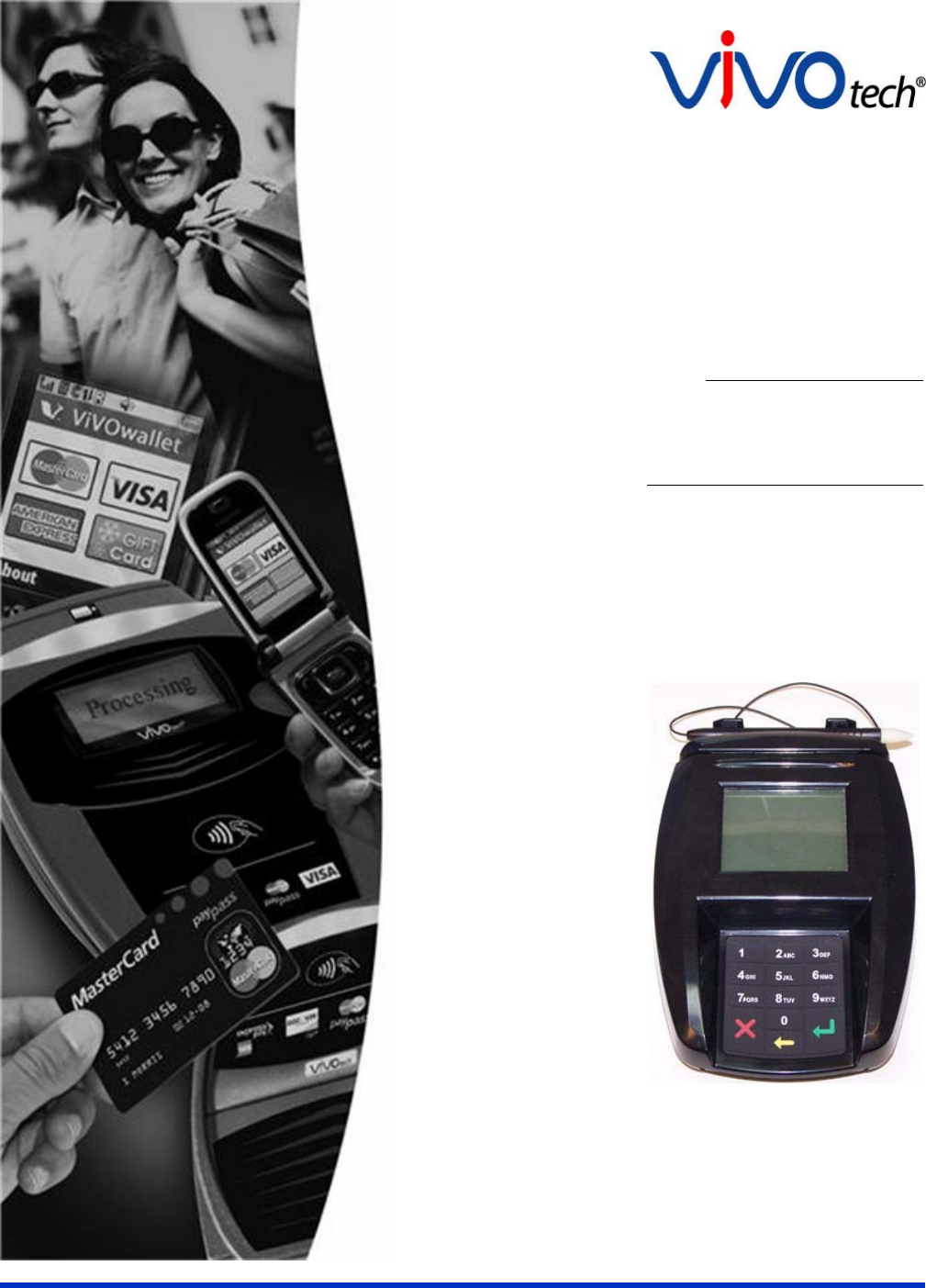
Part Number: 631-1075
A
ViVOpay®
8600 User Guide
Version 0.9.0
ViVOtech, Inc. 451 El Camino Real, Santa Clara, CA 95050 Ph: (408) 248-7001
Email: info@vivotech.com URL: www.vivotech.com
Draft dated 120508

Copyright© 2008, ViVOtech® Inc. All rights reserved.
ViVOtech, Inc.
451 El Camino Real
Santa Clara, CA 95050
Written and designed at ViVOtech, Inc.
This paper, as well as the software and hardware described in it, is furnished under license
and may be used or copied online in accordance with the terms of such license. The
content of this paper is furnished for information use only, is subject to change without
notice, and should not be construed as a commitment by ViVOtech, Inc. ViVOtech, Inc.
assumes no responsibility or liability for any errors or inaccuracies that may appear in this
document.
Except as permitted by such license, no part of this publication may be reproduced or
transmitted by electronic, mechanical, recording, or otherwise, or translated into any
language form without the express written consent of ViVOtech, Inc. ViVOtech, ViVOwallet,
ViVOcard, ViVOpay, and ViVOgiftcard are trademarks or registered trademarks of
ViVOtech“, Inc. MasterCard Paypass is a trademark or registered trademark of
MasterCard, Inc. American Express ExpressPay is a trademark or registered trademark of
American Express, Inc.
Warranty Disclaimer: The services and hardware are provided "as is" and "as-available,"
and the use of the services and hardware is at its own risk. ViVOtech does not make, and
hereby disclaims, any and all other express or implied warranties, including, but not limited
to, warranties of merchantability, fitness for a particular purpose, title, and any warranties
arising from a course of dealing, usage, or trade practice. ViVOtech does not warrant that
the services or hardware will be uninterrupted, error-free, or completely secure.
December 2008
Draft dated 120508

Regulatory Compliance
FCC Part 15 Class B Equipment
This equipment has been tested and found to comply with the limits for a Class B digital
device pursuant to Part 15 of the FCC Rules. These limits are designed to provide
reasonable protection against harmful interference in a residential installation. This
equipment generates, uses, and can radiate radio frequency energy and, if not installed
and used in accordance with the instructions, may cause harmful interference to radio
communications. However, there is no guarantee that interference will not occur in a
particular installation. This device complies with part 15 of the FCC rules. Operation is
subject to two conditions: (1) This device may not cause harmful interference, and (2) this
device must accept any interference received, including interference that may cause
undesired operation.
FCC Information for User
The users manual or instruction manual for an intentional or unintentional radiator shall
caution the user that changes or modifications not expressly approved by the party
responsible for compliance could void the user's authority to operate the equipment. In
cases where the manual is provided only in a form other than paper, such as on a
computer disk or over the Internet, the information required by this section may be included
in the manual in that alternative form, provided the user can reasonably be expected to
have the capability to access information in that form.
[54 FR 17714, Apr. 25, 1989, as amended at 68 FR 68545, Dec. 9, 2003]
Industry Canada Class B Equipment
This Class B digital apparatus complies with Canadian ICES-003
Cet appareil numérique de la classe B est conforme à la norme NMB-003 du Canada.
Industry Canada Information for User:
Operation is subject to the following two conditions: (1) This device may not cause harmful
interference, and (2) this device must accept any interference, including interference that
may cause undesired operation of the device.
Draft dated 120508
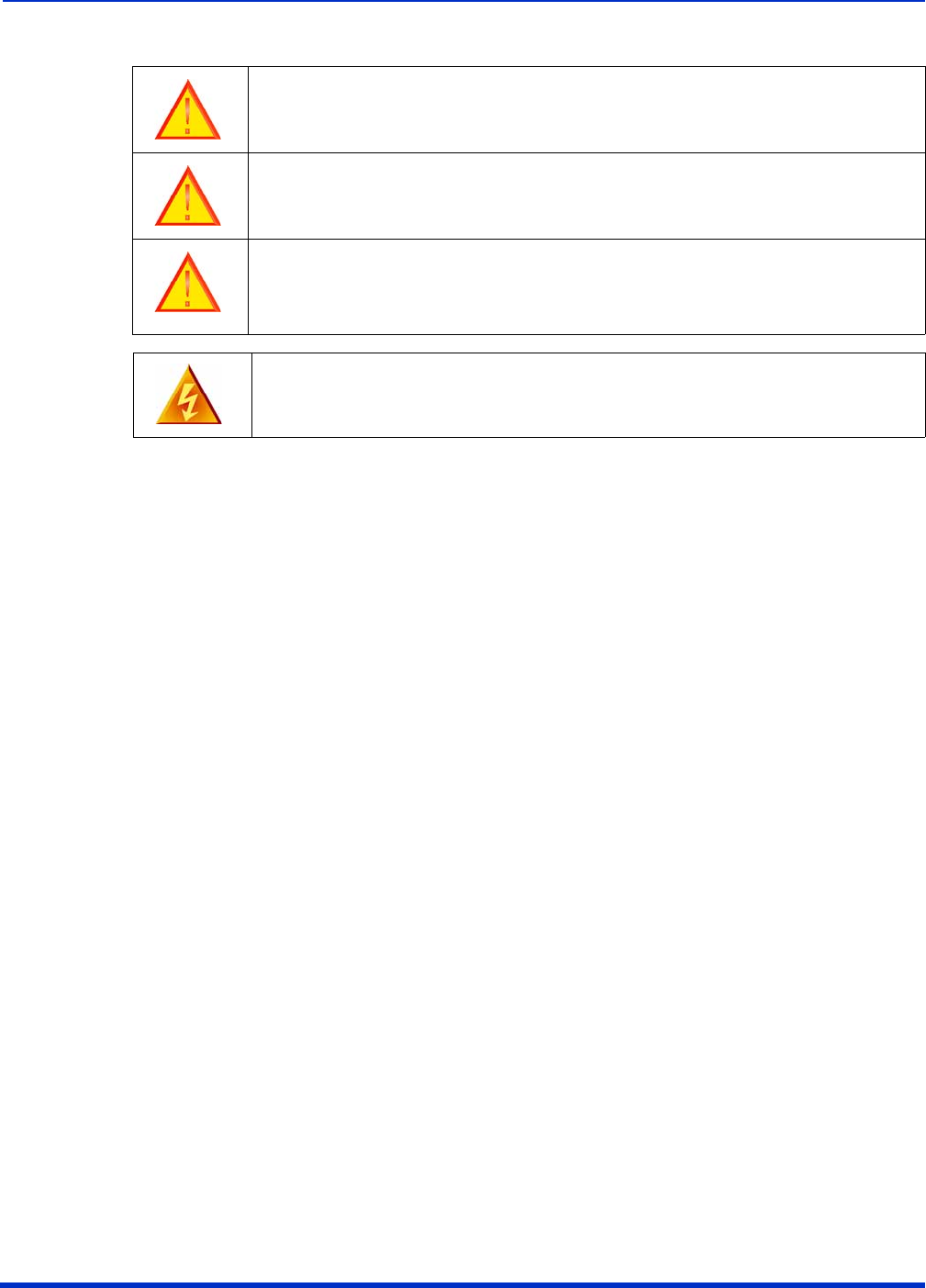
Cautions and Warnings
CAUTION: The unit should be mounted 1-2 feet away from other units. Can
be adjusted based on lane setup.
CAUTION: The unit should not be placed directly on or within 4 inches of
any large metal surfaces (does not apply to ViVOpay Vend).
CAUTION: Danger of Explosion if battery is incorrectly replaced. Replace
only with same or equivalent type recommended by the manufacturer.
Discard used batteries according to the manufacturer’s instructions.
WARNING: Avoid close proximity to radio transmitters which may reduce the
ability of the reader.
Draft dated 120508

ViVOtech Proprietary iv ViVOpay 8600 User Guide
Table of Contents
ViVOpay 8600 Overview ................................................................................... 1
Features . . . . . . . . . . . . . . . . . . . . . . . . . . . . . . . . . . . . . . . . . . . . . . . . . 1
ViVOpay 8600 Specifications ........................................................................ 2
PCI PED Compliance .................................................................................... 3
Testing to Verify PCI Compliance . . . . . . . . . . . . . . . . . . . . . . . . . . . . . 3
Can Another Customer Standing Nearby View the PIN? . . . . . . . . . . . . . . . 3
Can the Cashier View the PIN? . . . . . . . . . . . . . . . . . . . . . . . . . . . . . . . . . . 4
Can the Video Camera View the PIN? . . . . . . . . . . . . . . . . . . . . . . . . . . . . . 4
Retesting Requirements . . . . . . . . . . . . . . . . . . . . . . . . . . . . . . . . . . . . . . . . 4
Using an Additional Shield . . . . . . . . . . . . . . . . . . . . . . . . . . . . . . . . . . . . . . 4
Hardware Viewing Angles . . . . . . . . . . . . . . . . . . . . . . . . . . . . . . . . . . . . . . 5
Installing the ViVOpay 8600 .......................................................................... 6
ViVOpay 8600 Installation . . . . . . . . . . . . . . . . . . . . . . . . . . . . . . . . . . . 6
Using the ViVOpay 8600 ............................................................................. 10
Startup Sequence . . . . . . . . . . . . . . . . . . . . . . . . . . . . . . . . . . . . . . . . 10
Presenting Cards, Fobs, or NFC Phones . . . . . . . . . . . . . . . . . . . . . . . 10
Testing by Swiping a Card . . . . . . . . . . . . . . . . . . . . . . . . . . . . . . . . . . 11
Making a Purchase . . . . . . . . . . . . . . . . . . . . . . . . . . . . . . . . . . . . . . . 11
Troubleshooting .............................................................................................. 12
Glossary .......................................................................................................... 14
Customer Support .......................................................................................... 15
Draft dated 120508

ViVOtech Proprietary 1 ViVOpay 8600 User Guide
ViVOpay 8600 Overview
The ViVOpay 8600 seamlessly integrates with existing POS systems and requires minimal
counter space at checkout stands. The ViVOpay 8600 is a PCI 2.0 certified counter-top
contactless reader with integrated display, MSR, signature capture and PIN pad. This
device features a resistive touch pad, serial RS-232, and USB 2.0 connectivity.
ViVOpay 8600 supports the following contactless payment applications:
• PayPass ISO/IEC 144443
• MasterCard M/Stripe
•Visa MSD
• American Express – ExpressPay
• Discover Zip
• Mifare ePurse (Passthrough)
• ViVOcard 1 & 2
ViVOpay 8600 supports the following magnetic stripe applications:
• Debit/Credit
• Other (Loyalty, Promotions, Coupons, etc.)
This document assumes that users are familiar with their host POS systems and all related
functions.
Features
The following features are supported:
• Power - 9-12VDC regulated, 1.5 Amp
• ISO14443 type A/B Mifare based Contactless payment transactions (certified global
open-loop applications AND closed-loop applications)
• NFC enabled wallet content exchange
• PIN entry for PIN Debit transactions
• Magnetic-stripe card transactions
• Electronic Signature capture
Draft dated 120508
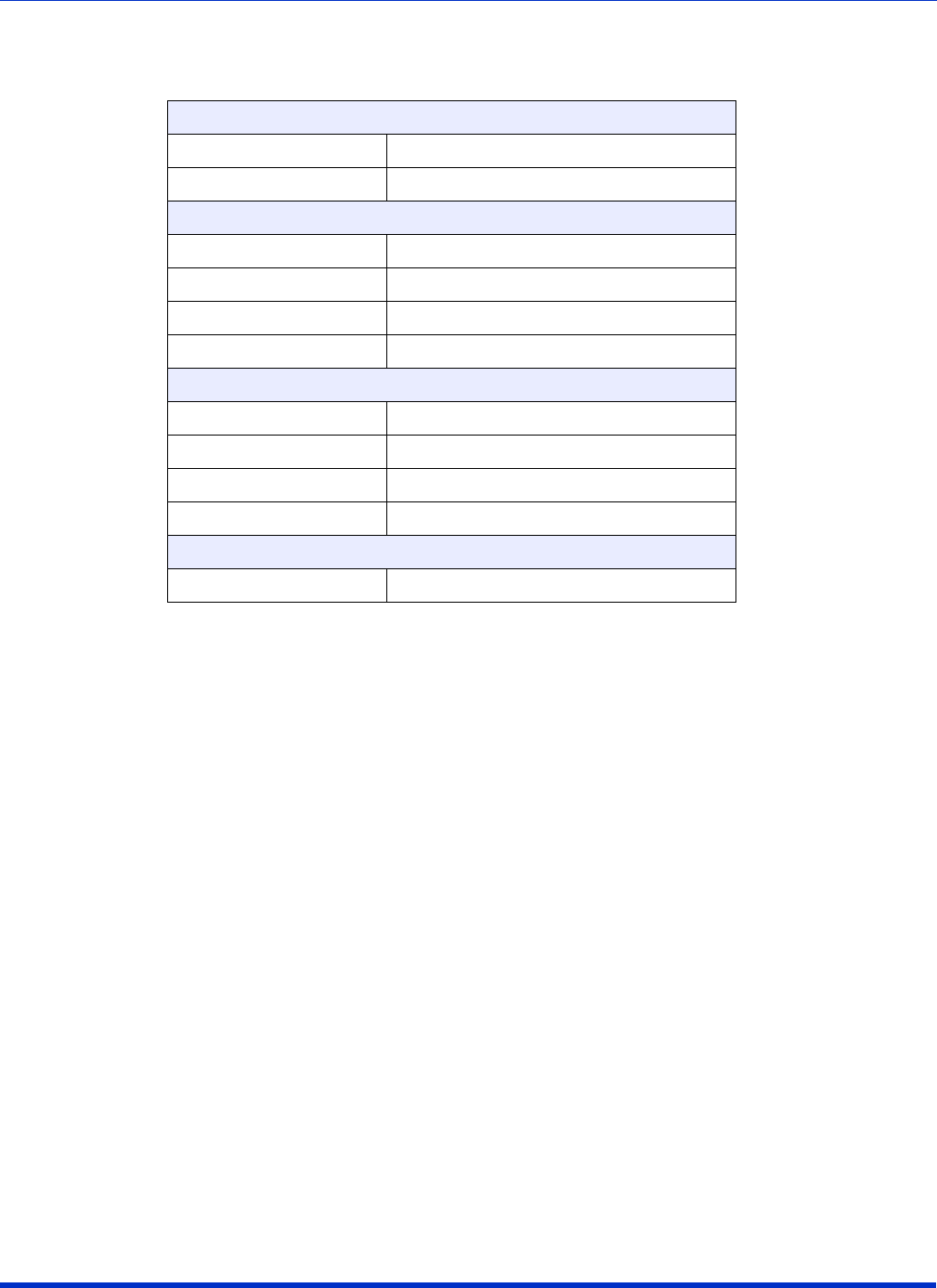
ViVOtech Proprietary 2 ViVOpay 8600 User Guide
ViVOpay 8600 Specifications
Hardware
Contactless 13.56 MHz
Interface ISO 14443 Type A/B
Physical
Length 179.65 mm (7.07 in)
Width (Widest) 129.45 mm (5.1 in)
Depth 51.03 mm (2 in)
Weight 0.4 Kg (0.9 lbs)
Environmental
Operating Temperature 0° to 40° C (32° to 104° F)
Storage Temperature. -20° to 70° C (-4° to 158° F)
Operating Humidity 10% to 90% non-condensing
Operating Environment Indoor only
Power
Voltage 9-12VDC regulated, 1.5 Amps
Draft dated 120508

ViVOtech Proprietary 3 ViVOpay 8600 User Guide
PCI PED Compliance
The ViVOpay 8600 is a PCI 2.0 certified PIN-Debit capable payment device. As part of the
PCI 2.0 certification it is required that sufficient protection must be provided to ensure that
the PIN number CANNOT be viewed by a 3rd party (e.g. another customer standing
nearby, the cashier or security camera etc) when being entered.
The ViVOpay 8600 has design elements such as a recessed keypad which meets SOME of
these requirements HOWEVER it is essential that the device should be installed with the
following considerations in order to fully implement this requirement.
1. The device must be in a location that will NOT force a customer to enter a PIN that can
be viewed by a 3rd party (i.e. a customer may tilt or rotate the device for better
accessibility due to objects blocking card-swipe for example).
2. If the device is elevated due to the use of a mounting stand then sufficient shielding
must be provided on the mount to prevent a PIN being viewed by a 3rd party.
3. If the device is mounted on a counter top, additional shielding (this can include other
devices such as the cash register as long (1) above is met) must be provided to ensure
that the PIN cannot be viewed by a 3rd party (including cashier and security camera).
Testing to Verify PCI Compliance
Before the installation is finished, the installer must verify that the ViVOpay 8600 is
positioned so that the PIN entry is not visible to other customers, the cashier behind the
counter, or to video surveillance cameras. If the PIN entry is visible, the ViVOpay 8600
must be repositioned so that the PIN entry is secure.
These test usually require at least 2 people - 1 to simulate entering the PIN and the other
person to attempt to view the PIN.
Can Another Customer Standing Nearby View the PIN?
While one person stands at the ViVOpay 8600 with their hand positioned to enter the PIN,
the other tester should stand beside the first person and see if they can observe the PIN
keypad. The second tester should move around a little to see if there is a position where
they can observe the PIN entry to learn the customer PIN.
If the PIN can be observed from any position, the ViVOpay 8600 might have to be
repositioned and retested. If there is a single location where the PIN can be observed,
consider placing a display such that the observation position is blocked so that the person
cannot get in the position to observe the PIN entry.
Warning: PCI requires that the device is mounted so that the PIN entry can not be
observed by a 3rd party (such as another customer standing in line, the cashier at the
counter, or a security camera mounted in the ceiling to observe the cash register area). If
the PIN entry can be observed, the store owner may be responsible for any losses
incurred by the customer if it can be determined that the customer’s PIN was stolen at
this location.
Draft dated 120508
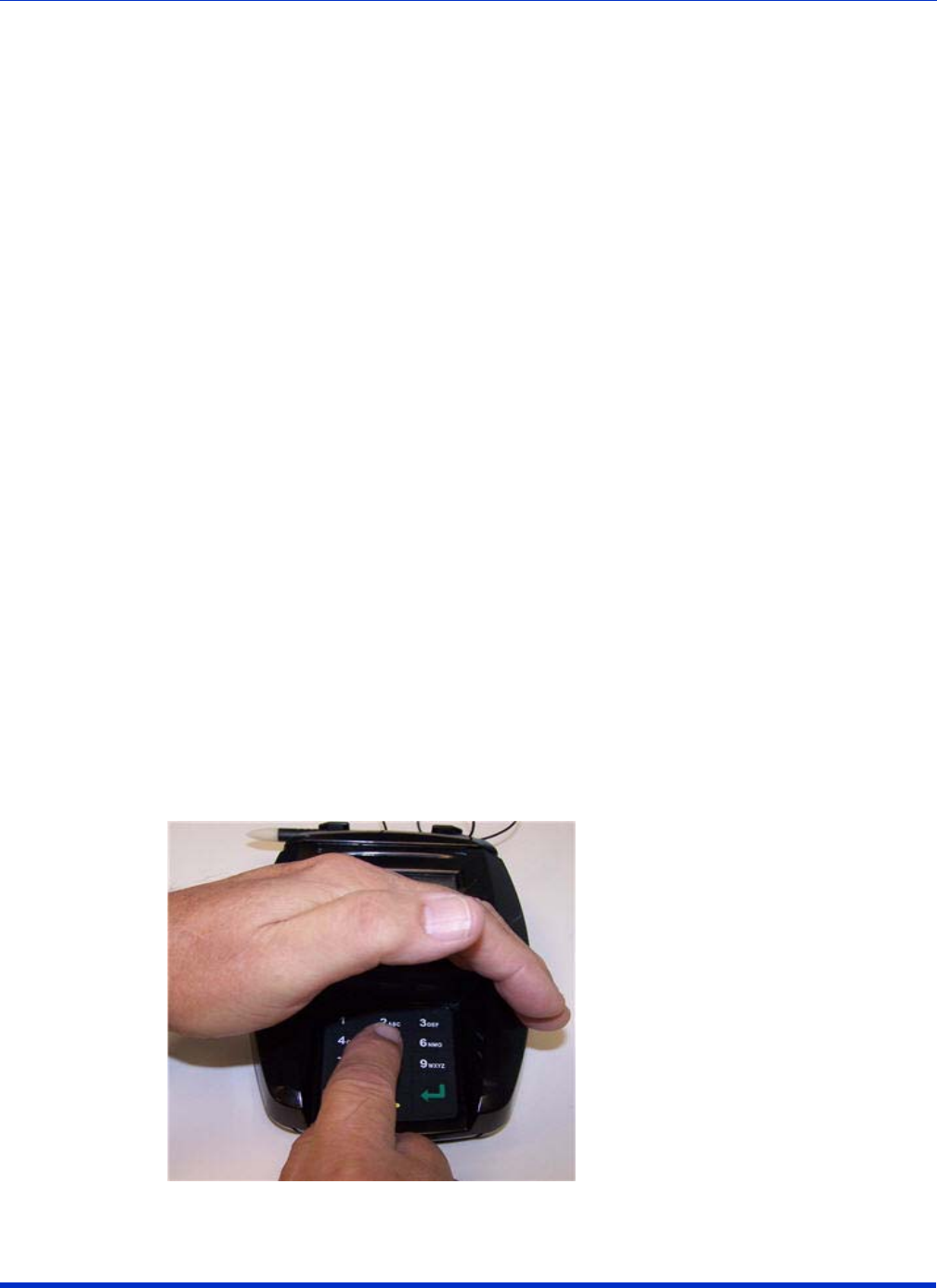
ViVOtech Proprietary 4 ViVOpay 8600 User Guide
Can the Cashier View the PIN?
While one person stands at the ViVOpay 8600 with their hand positioned to enter the PIN,
the other tester should stand behind the counter and see if they can observe the PIN
keypad. The second tester should move around a little to see if there is a position where
they can observe the PIN entry to learn the customer PIN.
If the PIN entry can be observed by the cashier, the ViVOpay 8600 must be repositioned so
that it is not observable by the cashier.
Can the Video Camera View the PIN?
While one person stands at the ViVOpay 8600 with their hand positioned to enter the PIN,
the other tester should observe what is being recorder by the video camera. This may
require playing back the recording to see if the PIN entry is visible. If the video camera is
moveable, the second person should move the video camera to determine if there is a
position where the PIN entry can be observed.
If the PIN entry can be observed by the video camera, the ViVOpay 8600 must be
repositioned so that the PIN entry is not observable by the camera.
Retesting Requirements
If the PIN entry on the ViVOpay 8600 is observable in any of the above testing, you must
reposition the ViVOpay 8600 and completely retest all locations to verify that the device is
situated correctly so that the PIN entry is not visible.
Remember, repositioning the ViVOpay 8600 to block observance of the PIN entry at one
location may expose the PIN entry at another location. PCI requires the repositioning and
retesting be done until the ViVOpay 8600 PIN entry is secure from observation.
Using an Additional Shield
At times, it may be impossible to position the ViVOpay 8600 so that the PIN entry is
blocked from viewing at all positions - especially from overhead cameras. In these
instances, the cashier should advise the customer to use their other hand to block any
observation of the PIN entry.
Draft dated 120508
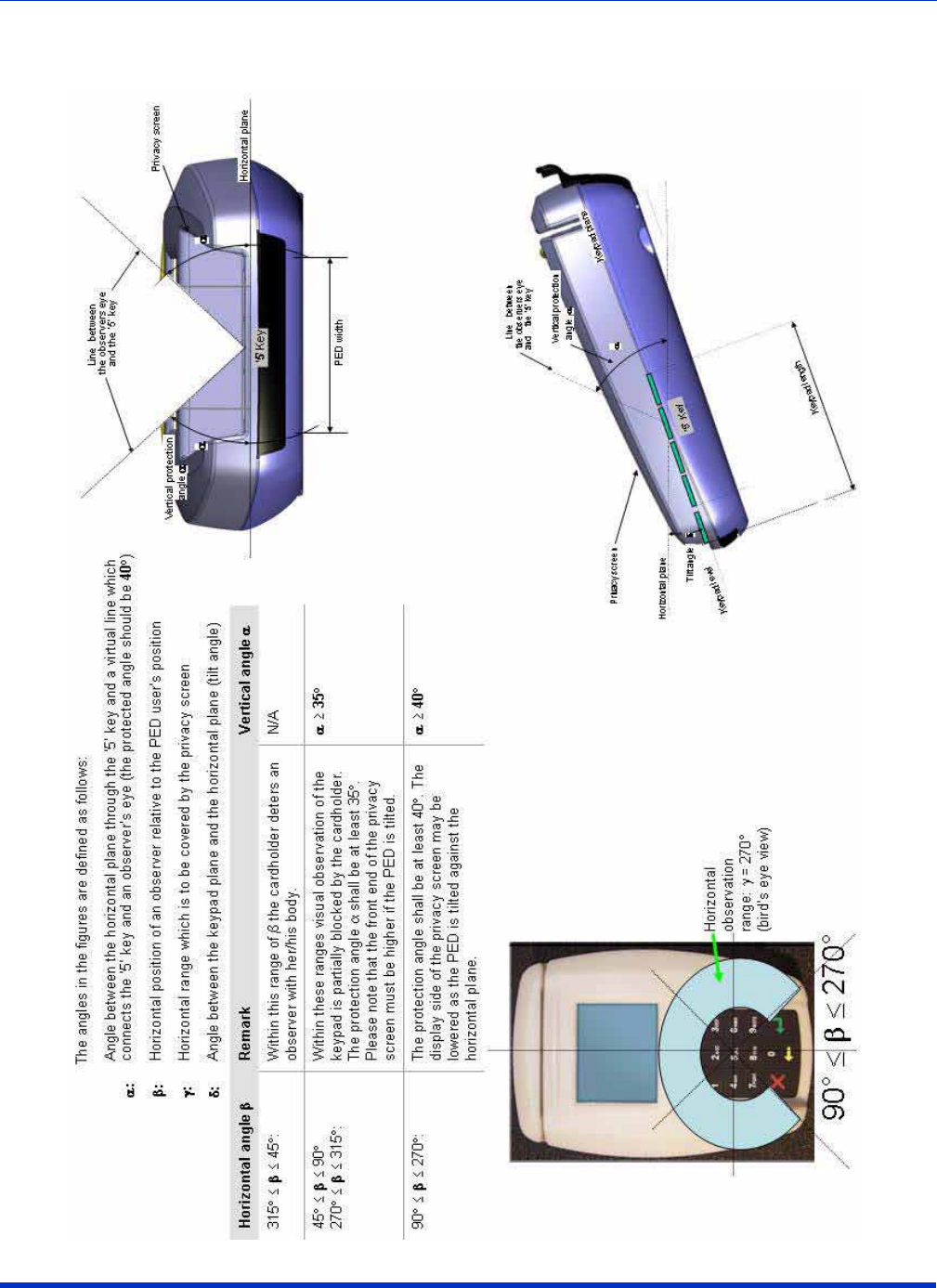
ViVOtech Proprietary 5 ViVOpay 8600 User Guide
Hardware Viewing Angles
Draft dated 120508
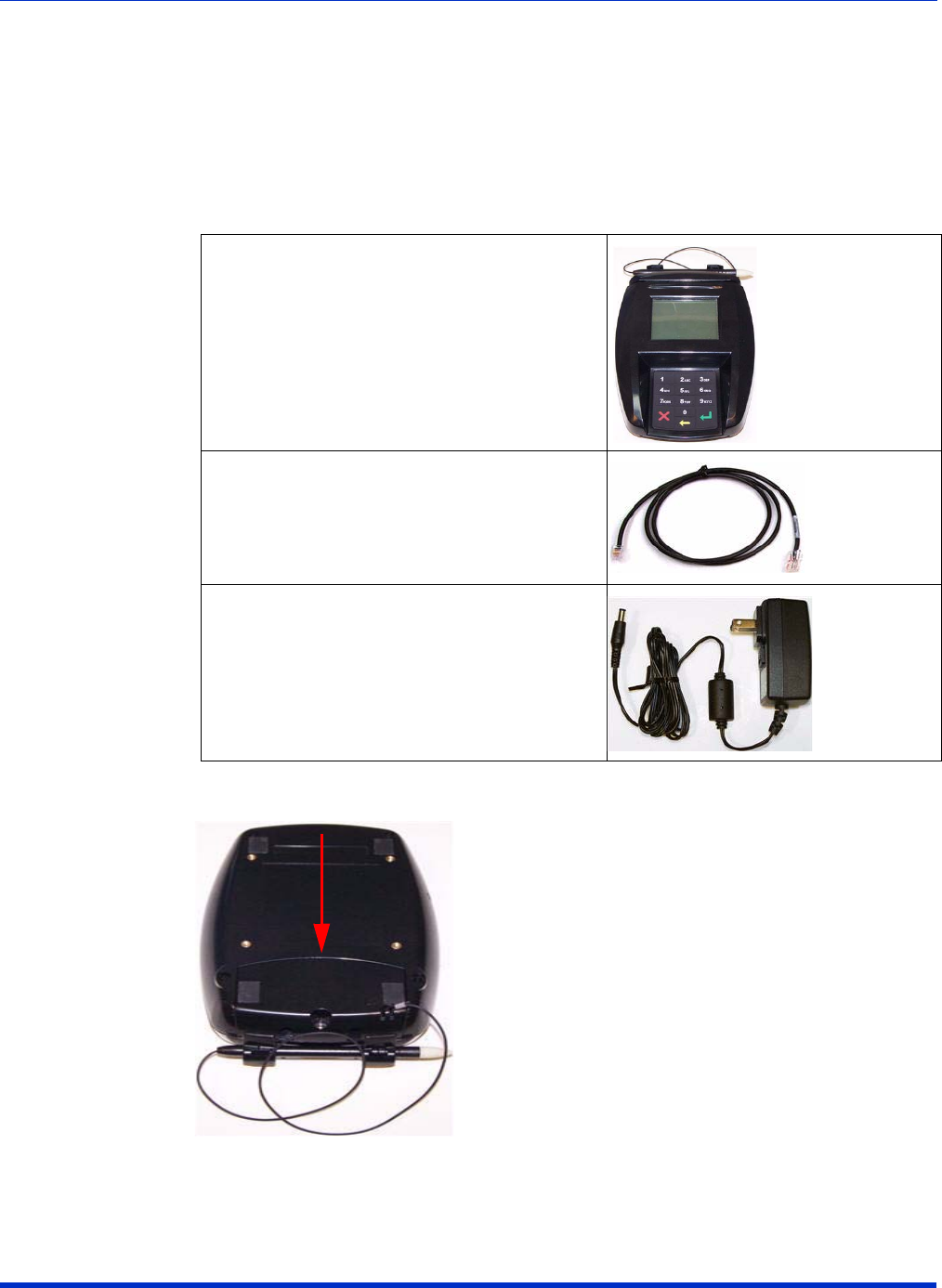
ViVOtech Proprietary 6 ViVOpay 8600 User Guide
Installing the ViVOpay 8600
This section describes how to install the ViVOpay 8600. Installation methods may vary
depending upon the location of the POS and counter configuration.
ViVOpay 8600 Installation
1. Verify that you have all the required components for the installation.
2. Turn the ViVOpay 8600 over so that the connector cover is visible.
ViVOpay 8600 (Part Number 525-2299-00)
Data Cable (varies by POS)
Power Module (Part Number 140-2035-00 -
US version)
Draft dated 120508
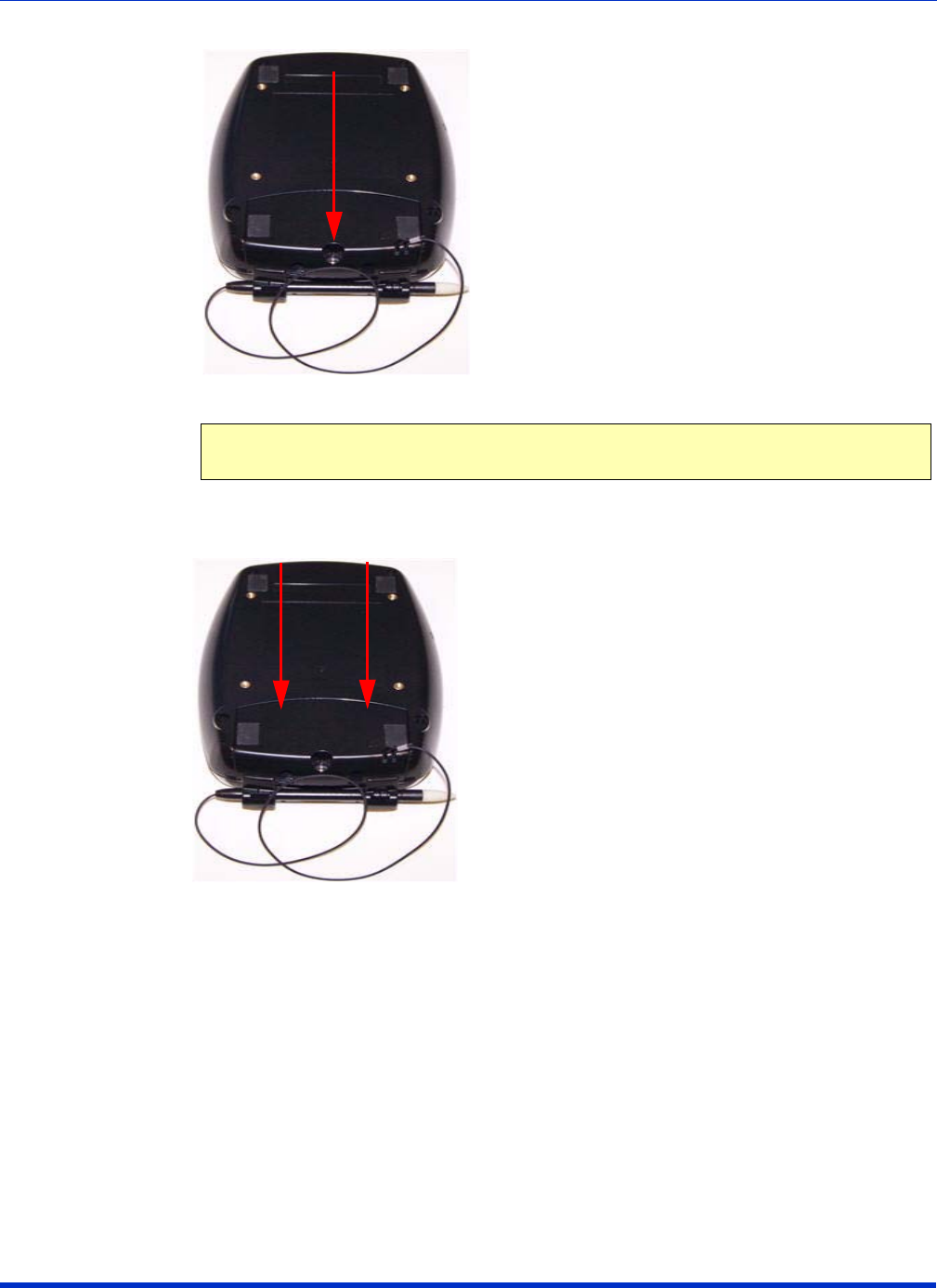
ViVOtech Proprietary 7 ViVOpay 8600 User Guide
3. Use a Phillips #1 screwdriver to remove the screw holding the connector cover in place.
4. Remove the connector cover by sliding the cover away from the unit.
.
Note: do not pry the door upward to remove it from the base as it will damage the
ViVOpay 8600 and possibly break the connector cover.
Draft dated 120508
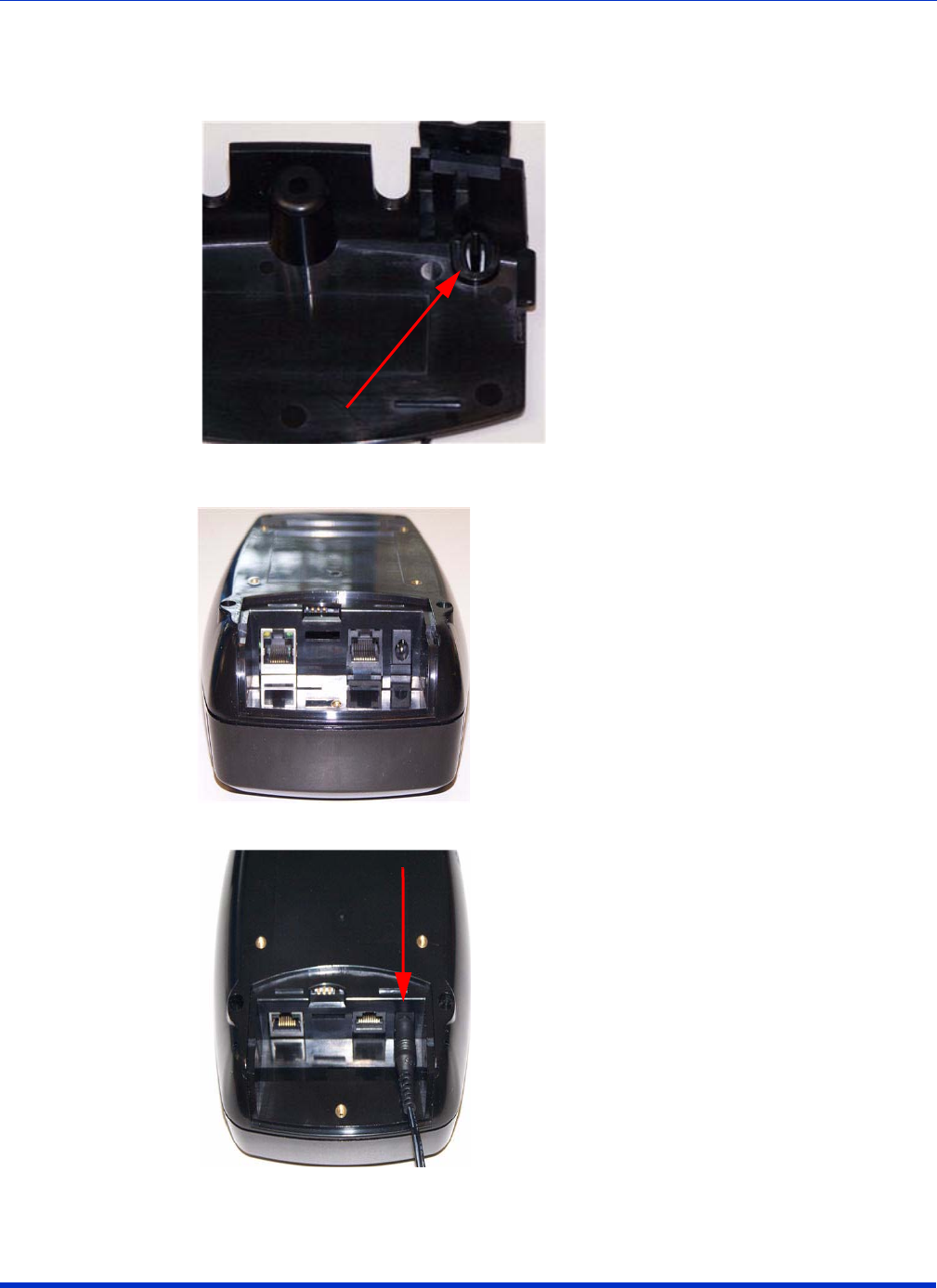
ViVOtech Proprietary 8 ViVOpay 8600 User Guide
5. Verify that the lanyard for the stylus is attached to the bottom of the connector cover. If
it has become detached, insert the loop of the lanyard into the slot on the connector
cover, loop it over the retaining pin, and pull the lanyard away from the slot opening to
secure it in place.
6. Position the ViVOpay 8600 so that you can access the sockets in the base of the unit.
7. Insert the power cable into the power socket.
Draft dated 120508

ViVOtech Proprietary 9 ViVOpay 8600 User Guide
8. Plug the data cable into the RJ45 socket directly beside the power socket.
9. Carefully slide the connector cover back into place being careful to align the cables into
the slots. One cable should be in each slot.
10.Secure the connector cover using the Phillips screw.
11.Place the stylus in the holder at the back of the ViVOpay 8600.
12.Attach the serial data cable from the ViVOpay 8600 to the appropriate port on the POS.
13.Plug in the power adapter. The ViVOpay 8600 emits a double beep and the left LED
illuminates. The LCD backlight turns on.
Note: It takes approximately 30-45 seconds for the ViVOpay 8600 to boot up once
power is applied. The unit is not usable until the Welcome screen appears.
Note: The socket on the left in the above illustration is an Ethernet port and is
currently unused. Do not plug the data cable into this port.
Draft dated 120508
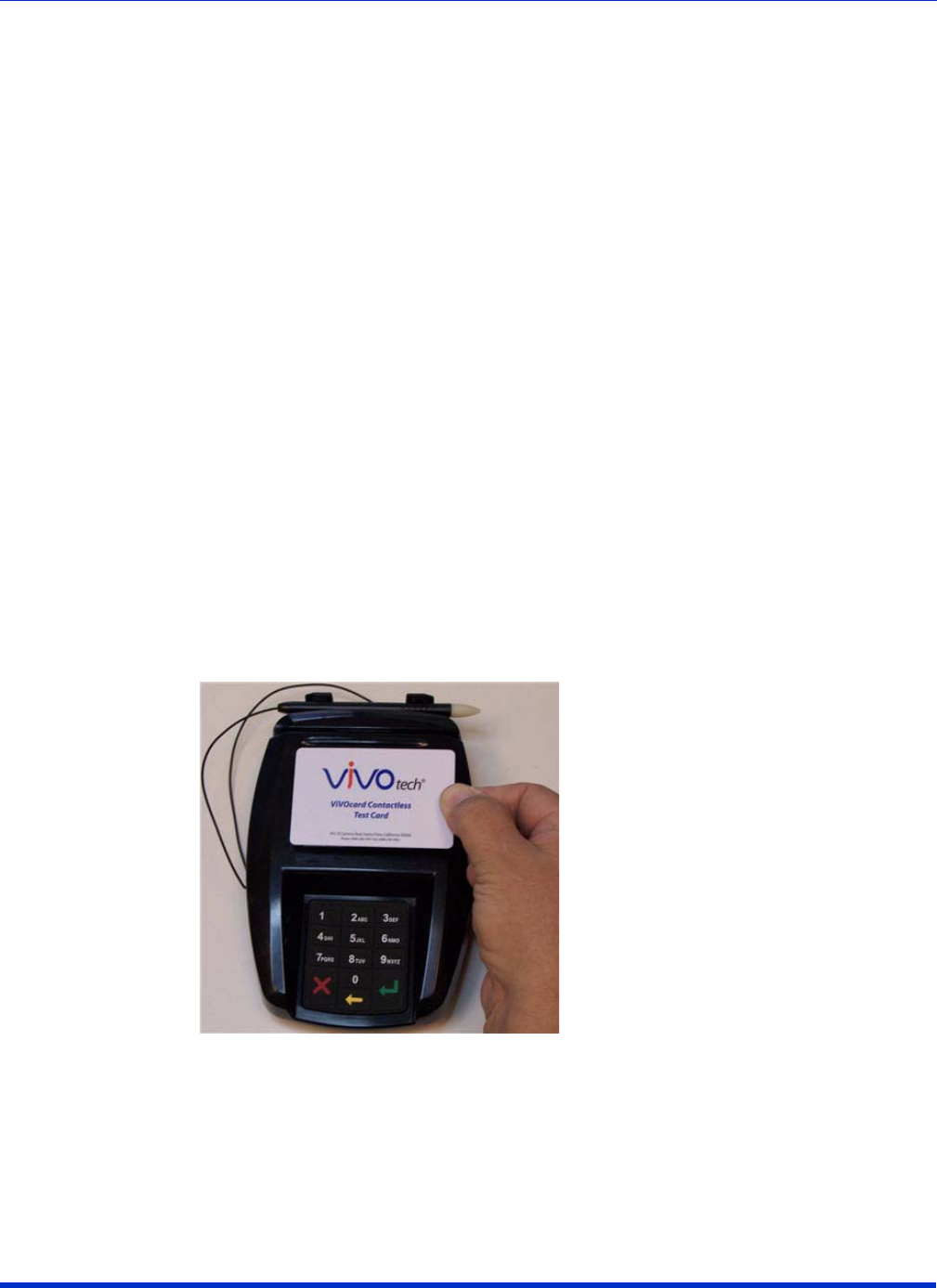
ViVOtech Proprietary 10 ViVOpay 8600 User Guide
Using the ViVOpay 8600
Startup Sequence
The ViVOpay 8600 emits a double beep when power is applied. The LEDs flash during
startup until only the left-most (power) LED is lit..
Note:
It takes approximately 30-45 seconds for the ViVOpay 8600 to boot up once power is applied.
The unit is not usable until the
Welcome
screen appears.
The display shows the opening screen which contains the following:
• ViVOtech screen
• Copyright screen
• Firmware Version screen
It should then display Welcome or Please present card or similar wording, depending
upon the configuration.
If the unit fails to power up, try reseating the power connector (or change to a different
power outlet).
If the unit still fails to power up, try replacing the power supply. If the unit still fails to power
up, and the power supply is definitely good, then the unit should be rejected as a failure
and returned to your local support representative.
Presenting Cards, Fobs, or NFC Phones
Present the card/fob/phone in close proximity to the reader and so that maximum surface
area is parallel to the LCD screen.
When a card/fob/phone has been successfully read, an audible beep is emitted and all
green LEDs illuminate.
If you use a test card and the reader is attached to the POS, a dummy transaction can be
tested. The transaction will not be authorized and will come back with a decline, but will at
least test for end-to-end connectivity.
Draft dated 120508
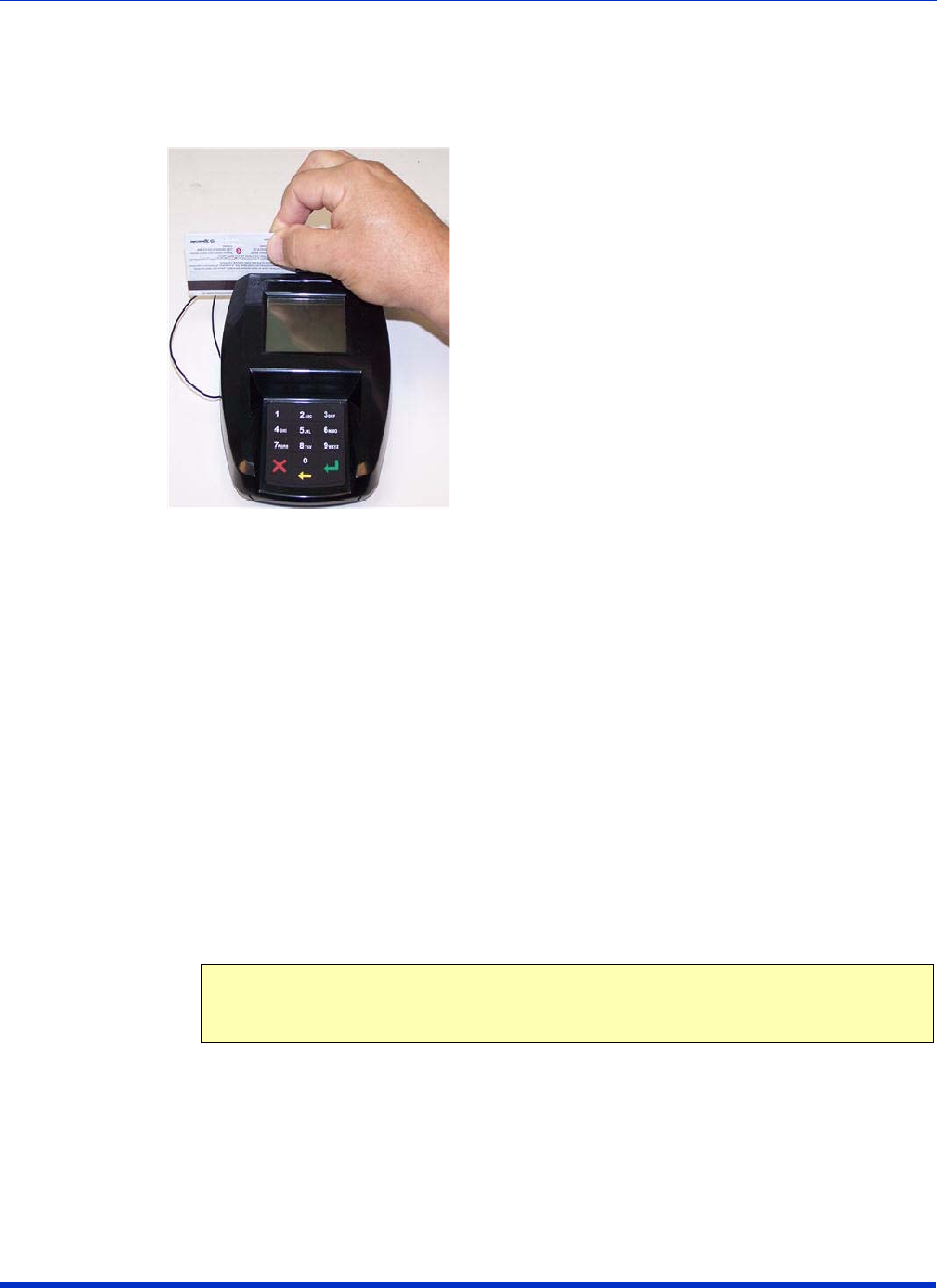
ViVOtech Proprietary 11 ViVOpay 8600 User Guide
Testing by Swiping a Card
To test the magstripe reader, you need to ring up a sale on the register or POS and swipe
a magstripe card through the slot. For correct orientation, the magstripe should be visible
and at the bottom of the card as illustrated below.
When a magstripe card has been successfully read, an audible beep is emitted and all
green LEDs illuminate.
Making a Purchase
The exact wording that appears on the ViVOpay 8600 depends on the POS used and the
application that is running on it.
1. After the transaction has been rung up on the POS, the ViVOpay 8600 may show
Welcome or similar wording. The customer should now present their card/fob/phone in
close proximity to the reader.
2. A single beep and the LED flashes to indicate that the card/fob/phone has been
validated. The ViVOpay 8600 may display Processing or similar wording while the
transaction is being processed.
3. If the software requires a PIN entry, you will see Please enter PIN. Use the keypad to
enter the PIN.
4. If the software requires a signature, you will see Please sign below. Use the stylus to
enter your signature.
5. A receipt is printed by the POS with the purchase amount. The ViVOpay 8600 may
show Thank You or similar wording for a successful transaction.
Note: Only use the stylus to write on the LCD screen. If you use another instrument
such as a ball point pen, you can damage the LCD screen which may require that
the ViVOpay 8600 be replaced.
Draft dated 120508
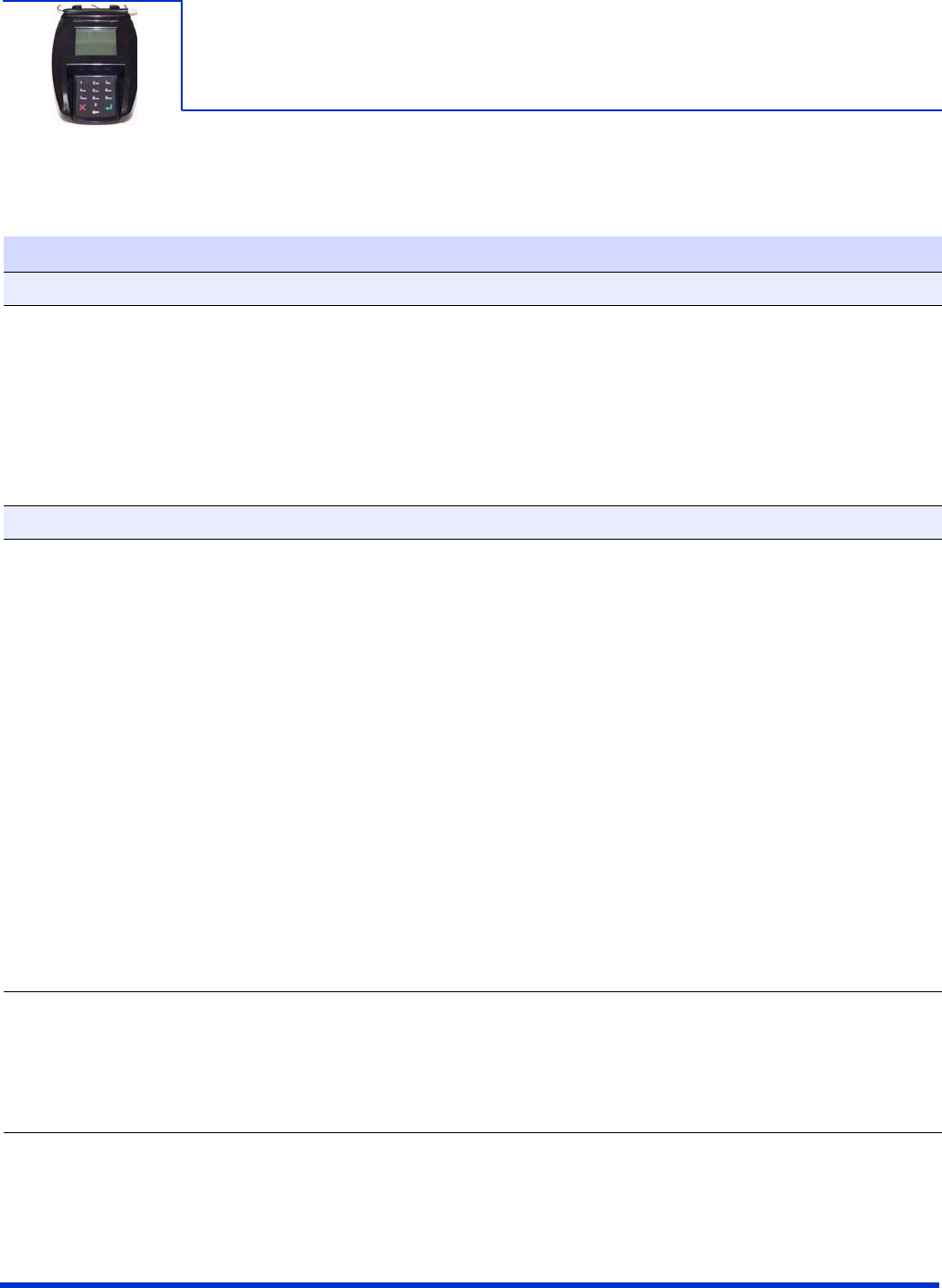
ViVOtech Proprietary 12 ViVOpay 8600 User Guide
Troubleshooting
The ViVOpay 8600 readers are reliable and easy to troubleshoot. The components that may
require troubleshooting include the power module, the reader and the data cable.
Symptom Possible Cause Remedy
General Issues
Reader does not appear to be
powered
on --- no LEDs lit, no
LCD display.
• Reader not powered on or
incorrect voltage.
• Incorrect power supply used.
• Check cable connections.
• Verify that power is on and correct
voltage and current are present.
• Replace the power module.
• Verify that power cable plug is fully
inserted.
• Replace the power module.
• Replace the reader.
Reading Cards/Fobs/Phones
LEDs do not light and beeper is not
audible when card/fob/phone is
presented.
• Card/fob/phone not properly
presented.
• Metal or RF interference.
• Firmware issue (contact your
local support representative).
• Reader not powered on or
incorrect voltage.
• Incorrect power supply used.
• Unsupported card/fob/phone
used.
• Present card/fob/phone closer to the
reader antenna and ensure it is
parallel to the face of the reader.
• Verify that the card/fob/phone is
valid/current.
• Test with “ViVOcard Contactless Test
Card” part number 241-0015-03 Rev
A.
• Verify that the Phone Wallet is enabled
for payments.
• Try a different card/fob/phone.
• Verify that the unit is not near any
large metal objects.
• Verify that correct firmware is loaded
(local support representative only).
• Verify that power is on and correct
voltage and current are present.
• Verify that power cable plug is fully
inserted.
• Replace the reader.
Some cards/fobs/phones read, but
not all.
• Wrong firmware (contact your
local support representative).
• Possible bad card/fob/phone.
• Unsupported card used.
• Verify that correct firmware is loaded
on reader (local support
representative only).
• Check to see if card/fob/phone is
damaged.
• Try a different card/fob/phone.
Draft dated 120508

ViVOtech Proprietary 13 ViVOpay 8600 User Guide
Communication to POS/ECR
No data is received, or data is
garbled.
• Faulty or incorrect cable
connections.
• Unsupported card used.
• Contactless application is not
installed on terminal (for serial
connections only).
• Magstripe card not swiped
correctly.
• Magstripe card not level during
card swipe.
• Check that the cable connection is
secure and in the correct port on the
POS/ECR.
• Check that the POS/ECR has the
correct software application to accept
data from the contactless reader
(may need assistance from the POS
vendor).
• Try a different card/fob/phone or
magstripe card if testing the
magstripe reader.
• If testing with the magstripe card, try
turning the card around; make sure
that the card is level during the card
swipe.
• Contact the payment processor for an
application upgrade.
• Check that the cable is correctly
attached to the back of the ViVOpay
8600
Symptom Possible Cause Remedy
Draft dated 120508

ViVOtech Proprietary 14 ViVOpay 8600 User Guide
Glossary
Electronic Cash Register (ECR)
The combination of a traditional cash register and a POS terminal, often PC-based.
ExpressPay from American Express
American Express contactless payment product that utilizes contactless technology.
Firmware Software that is embedded in a hardware device that allows reading and executing the
software, but does not allow modification, e.g., writing or deleting data by an end user.
Example: Firmware is a computer program in a read-only memory (ROM) integrated circuit
chip. A hardware configuration is usually used to represent the software.
Example: Firmware is a program embedded in an erasable programmable read-only memory
(EPROM) chip, which program may be modified by special external hardware, but not by an
application program.
Fob A key chain device or other non-standard credit card sized form factor that has an embedded
radio frequency (RF) chip.
MasterCard PayPass
MasterCard's contactless payment product that utilizes contactless technology.
MTBF Mean time between failure. MTBF is the average time a device will function before a failure.
NFC Near Field Communications.
NFC Phone Near Field Communications (NFC) phone. A technology that enables communication between a
secure element in a mobile device and a contactless reader to make credit/debit payments.
Also see UICC.
Point of Sale (POS)
Refers to terminals used in retail stores with a magnetic stripe reader, keyboard, display and
autodialer modem or IP connection, connected to the telephone/internet network and used for
on-line credit/debit authorization. Can also be connected to a host computer, which handles all
transaction processing including item price look-up, data collection, and credit/debit
authorization.
Proximity Payments
Payment method utilizing contactless technology such as RF, Infrared (IrDA) or Near Field
Communications (NFC).
Radio Frequency (RF)
Any frequency that corresponds to radio signals, including those used by cellular telephones
and wireless networks.
RF Reader The Point of Sale device that receives the RF transmission from a card, fob or NFC phone.
UICC The UICC (Universal Integrated Circuit Card) is the chip card used in mobile terminals in GSM
and UMTS networks.
Visa Contactless
Visa's contactless payment product that utilizes contactless technology.
Draft dated 120508

ViVOtech Proprietary 15 ViVOpay 8600 User Guide
Customer Support
Contact your local support representative for all support questions.
Draft dated 120508